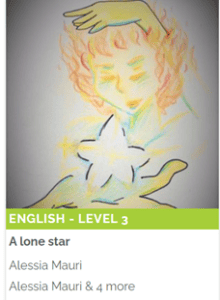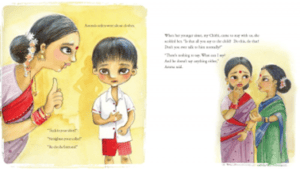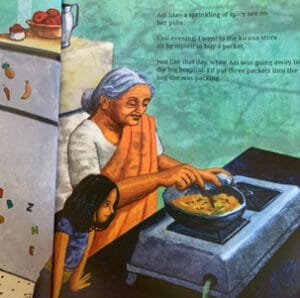In the world of literature, picture books hold a special place. Combining narratives with visually stunning illustrations. These images have the power to ignite imagination and instill a love for reading in young minds.
The joy of reading is complete when the wealth of information is married to visuals. This is based on the Constructivism approach, where the students construct new understanding when reading a story. When students read, they are engaged in understanding the story through text, and then analyzing visuals becomes a part of their new knowledge through keen observation and inferences.
Visual Literacy Is Analytical Thinking
Reading visuals, or analysing illustrations, is a valuable skill that goes hand in hand with reading comprehension. Just as we dissect the words on a page to uncover deeper meanings, exploring the visual elements of a picture book opens up a world of possibilities for critical thinking, collaboration, and attention to detail.
Visual literacy, the ability to interpret and make meaning from images, is a fundamental skill in today’s increasingly visual society. By engaging with the visual aspects of picture books, students enhance their understanding of the story and develop essential skills that can be applied across various disciplines.
Benefits of Visual Thinking
When we delve into the techniques of analyzing visual texts, we empower our students
– To think critically
– Ask questions beyond what meets the eye
– Sharing ideas and discussing the images leads to collaboration
– Keen observation
– Analytical thinking
– Learning how to create visuals
Here is a list of different strategies to help you teach and learn about visuals in picture books.
Different strategies to analyze visuals are identifying allegory, angles, body language, composition, colour, hue, and tone.
Using these strategies, librarians provide students with the tools to unlock the hidden layers of meaning in the illustrations they encounter.
1 Allegory in visual literacy
Allegory is a powerful storytelling technique where a story or visual image contains a hidden or symbolic meaning beyond its literal meaning. Allegory sometimes uses personification, giving humans shape to abstract concepts, and can be seen as an extended metaphor. Picture books are rich with examples of allegorical illustrations. For instance, a tree that represents growth and wisdom or a mirror reflecting self-discovery and identity. These visual cues give readers additional layers of meaning and invite them to engage in critical thinking. Allegory invites readers to explore the realms of imagination and symbolism, adding richness and complexity to their reading experience for older students.
For example:
– A Lone Star. A concise reflective metaphor about a poor little star. However, it can be a metaphor for a child: https://storyweaver.org.in/stories/180622-a-lone-star?mode=read
– Thunder Storm can be an allegory to life, https://storyweaver.org.in/stories/15875-a-thunderstorm
2. Angles a visual strategy
Angle is the second technique in analyzing visual texts; different angles play an important role in conveying a specific point of view. Angles are carefully chosen by illustrators to shape the viewer’s perception and evoke particular emotions or reactions. For example, low-angle shots, where the camera is positioned below the subject and looks upwards, create a sense of power and dominance. This angle makes the subject appear larger and more imposing, emphasizing their authority or strength.
On the other hand, eye-level positioning establishes a sense of equality and connection between the viewer and the subject. It allows readers to identify with the characters, immersing themselves in the story and fostering empathy. Picture book illustrations utilize angles to create meaning. This is a high-angle image that may give the symbol of courage and power.
By recognizing and analyzing the effects of different angles in picture books, readers develop a critical eye for visual storytelling. They become attuned to the intentional choices made by illustrators and gain a deeper appreciation for the impact of perspective in shaping meaning and interpretation.
Example: The angle in Fig 3 picture above indicates the power between the mother and the child and yet the closeness unlike Fig. 1
The second picture in Fig 3 indicates the closeness of the two characters as well as symbolizing an equal relationship; the positioning gives a sense of equality and connection of the two women.
The illustrator uses the low-angle shot/view in Fig 4. It gives the reader a glimpse into the cooked food (Poha).
3. Body Language and Gaze are other visual techniques:
When analyzing visual texts, paying attention to body language and gaze in picture book illustrations provides valuable insights into characters’ attitudes, emotions, and the overall narrative. Facial expressions, gestures, and body positions serve as powerful cues that reveal characters’ inner thoughts and feelings. A wide smile might convey happiness, while a furrowed brow could indicate worry or confusion. Open arms might signify welcome and warmth, while crossed arms may suggest defensiveness. By closely observing these subtle details, readers can better understand the characters’ personalities and motivations. Equally important is the direction of the character’s gaze. Where characters are looking can convey their focus, interests, and relationships. A character looking directly at another might indicate engagement or connection, while averted eyes could imply shyness or guilt. The characters’ gaze toward particular objects or elements in the illustration can also provide clues about essential plot points or themes.
Observe the gaze of the people audience on the main character. It is full of fear, some filled with awe and others with laughter. What might that tell you about the main character, or what might that tell you about the audience in the picture?
In the title of the picture book Kesar and the Lullaby Birds Fig 6, ask students to look at the characters’ gaze. Where is the mother’s gaze? What is she feeling? What is her mood? Where is the man’s gaze? Where is the child’s gaze? Tell me something about the character’s personality. (The father’s gaze is endearing, yet he has a questioning expression while looking at the baby. Mother seems tired and ready to go to bed. Her relationship shows warmth and an open, loving relationship in the family. The little child’s gaze is towards the father with a questioning look)
Visual analysis is taught in middle and high school; learning to analyze visuals with younger students helps students think deeply and learn to look for elements beyond the surface level.





